Scottish Prison Population Statistics 2021-22
The latest longitudinal statistics on prison populations and flows into and out of prison. Includes information about the demographics of people in prison, the time they spend there, their sentences and offences.
This document is part of a collection
8 Population Transitions and Out-Flows
This section of the report examines transitions within, and departures from, custody in the reporting year. Quantification of population flows are provided, as well as an examination of custodial ‘journeys’ by legal status. Individuals can enter custody with any one of the legal statuses (untried, convicted awaiting sentence, or sentenced), and may transition through other statuses before departing[36]. For the custodial ‘journeys’ captured in the cellWise data, it is possible to measure and report overall time in custody, as well as time spent with a remand status. Where available, the reasons for an individuals’ liberation is provided in section 8.4.
8.1 Departures and transitions
[Supplementary Tables C1, O2, O3 & O4]
There were 10,474 departures[37] from prison in 2021-22, a decrease of less than 1% from 2020-21. Accounting for multiple departures per person, 8,518 individuals departed prison one or more times in 2021-22 – a increase of 1% (see Figure 22), but still far below the 2019-20 level of 11,457.
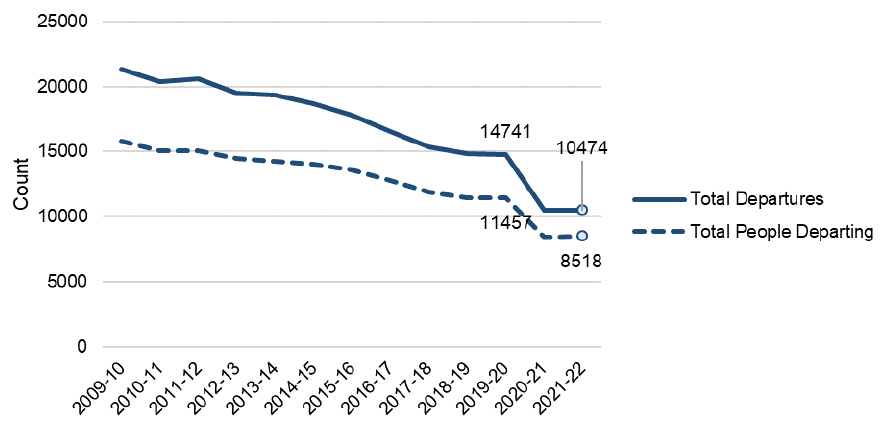
Of all departures[38] in 2021-22, 46% were from remand and 54% were sentenced. This is a greater proportion departing from a remand status than in previous years, albeit the difference is small (43% in 2020-21 and 44% in 2019-20). In absolute terms, the number of remand departures increased 6% from 4,489 in 2020-21 to 4,773 in 2021-22. In the same period departures from sentenced status decreased 5% from 5,942 to 5,628.
There were 3,847 transitions[39] from remand to sentenced status in 2021-22, around 12% more than in 2020-21 (3,445) but still 23% less than pre-pandemic (4,966 in 2019-20).
8.2 Custodial journeys
[Supplementary Tables C1 & O2]
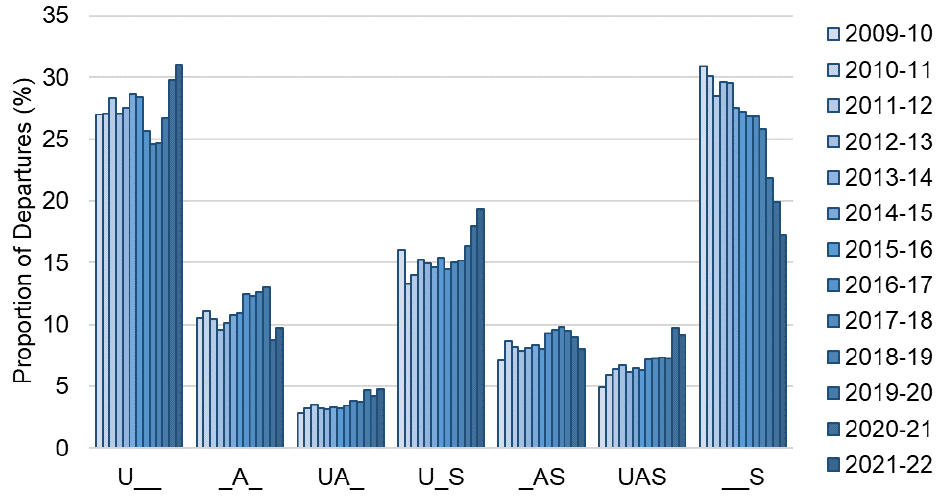
Figure 23 shows the proportion of departures by custodial journey type[40]. Journey types represent the progress through the legal status hierarchy[41] in the course of an occupancy period, from untried (U), convicted awaiting sentence (A) to sentenced (S). This demonstrates broad stability between 2020-21 and 2021-22, with only small proportionate increases in departures from a journey ending in remand and small proportionate decreases in journeys ending in the sentenced population (absolute counts are available via the interactive analysis tool and also show little change between 2020-21 and 2021-22).
8.3 Time in custody
[Supplementary tables D2]
The mean total duration of an occupancy period in custody increased steadily from 122 days in 2009-10 to 169 in 2019-20[42]. This increased by 47 days in 2020-21 to 216 days on average. A further increase was seen in 2021-22 when the average length of a completed occupancy period was 226 days (+10). This latest increase appears to have been driven by a continued reduction in the share of departing occupancy periods of 3-6 months and increase in those of 6-12 months, as shown in Figure 24.
Continuous periods in custody of up to 6 months made up 85% of all occupancy periods ending in 2009-10 and 77% in 2019-20, but just 69% in 2021-22.
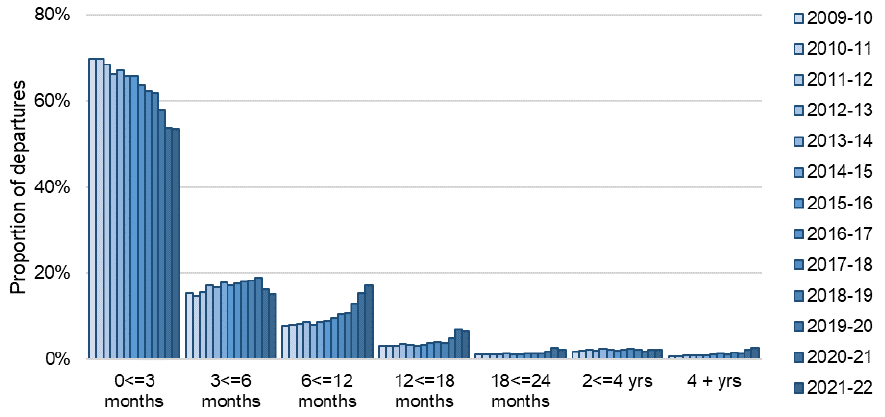
8.3.1 Time on remand
[Supplementary tables O2]
We can measure time on remand when an individual departs custody without a sentencing warrant in that occupancy period, or when they transition from a remand status to the sentenced population[43].
As shown in Figure 25, the median time taken for an individual to depart custody from remand remained approximately the same over the time series. In 2021-22 the median number of days to departure from remand was 22 days. However, while in 2019-20 90% of remand departures had occurred within 98 days, in 2020-21 this rose to 109 days. In 2021-22 it had risen further such that 10% of departures from remand took 139 days or more.
The time taken to transition from a remand status to the sentenced population also increased in 2021-22. The median number of days to transition in 2019-20 was 36, while in 2020-21 this rose steeply to 55. A smaller increase was seen in 2021-22 to a median of 57 days. In 2021-22 there was a substantial increase in the 90th percentile of time on remand before transition. In 2019-20, 90% of transitions occurred within 145 days and in 2020-21 this had risen to 175 days. In 2021-22 this rose further, such that 10% of transitions from remand to the sentenced population took 262 days or more.
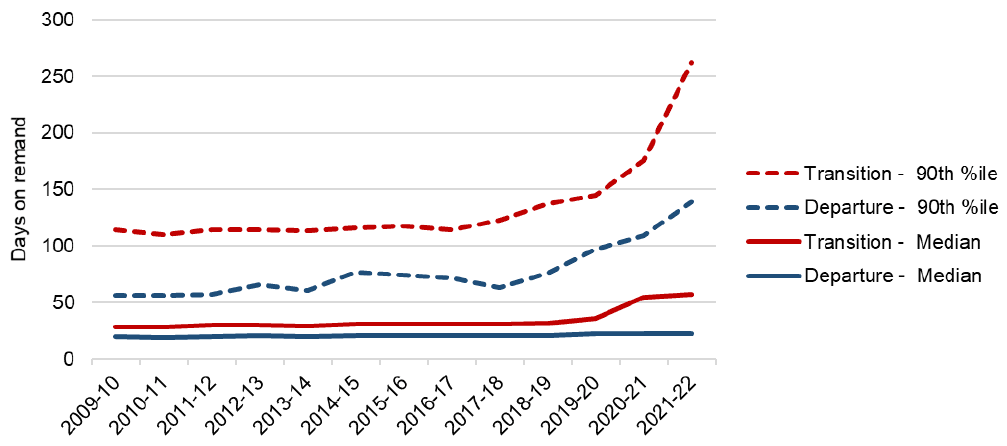
Earlier statistical releases[44] have explored the distribution of days spent on remand for all remand only journeys. In 2020-21, although remand only journeys of all lengths fell in number, the proportion share across duration bands remained broadly similar to 2019-20. The proportion of remand journeys lasting up to 7 days has remained around 22% over the past three reporting years. The proportion of remand journeys lasting more than 140 days rose from 5% in 2019-20 to 7% in 2020-21 then 10% in 2021-22.
8.4 Liberations
8.4.1 Liberations from remand
[Supplementary tables O4]
The overall volume of recorded liberation types for departures from remand increased by 6% between 2020-21 and 2021-22, from 4,489 to 4,773.
The number of court or procurator fiscal liberations increased 15%, from 2,811 in 2020-21 to 3,241 in 2021-22. This follows a large (52%) decrease in this liberation type in the first pandemic year.
In 2019-20, 528 remand departures were liberated to bail, but in 2020-21 this increased almost threefold to 1,544 (Figure 26). In 2021-22 this fell 10% to 1,393.
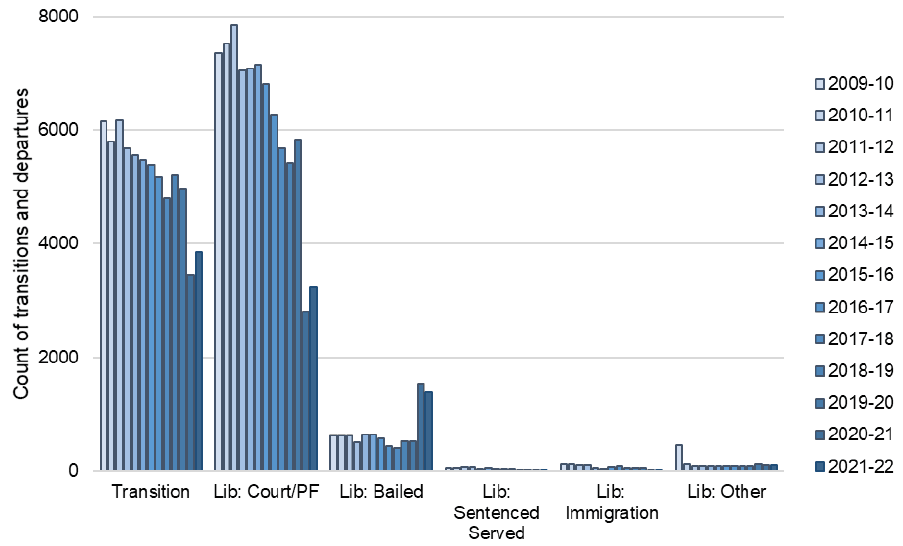
The time to departure varies depending on the type of liberation. Figure 27 shows the median and 90th percentile days on remand by liberation type. Liberations to bail is of particular interest here, with the median time to liberation staying constant between 2019-20 and 2021-22 at 8 days. However, 10% of those liberated to bail remained in custody for 114 days or more in 2021-22 and 115 days or more in 2020-21, compared with just 31 days or more in 2019-20.
Median time to liberation from remand by the courts or procurator fiscal remained constant from the previous year, while the 90th percentile increased from 100 to 141 days.
Days on remand until transition is described in section 8.3.1.
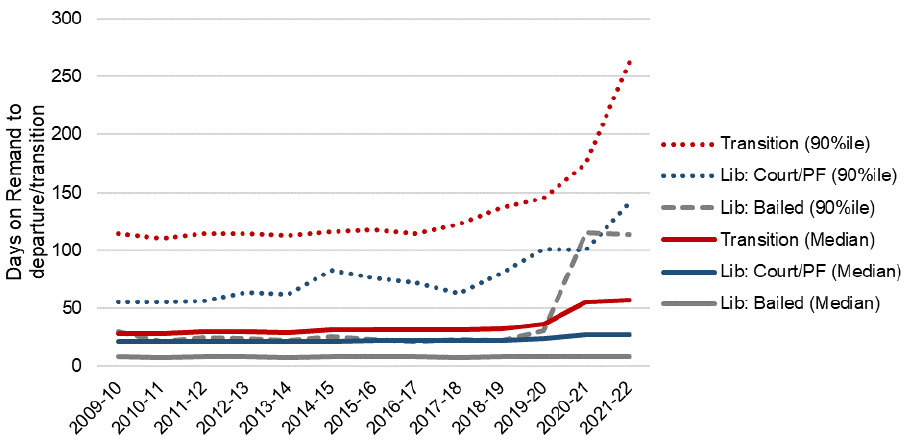
8.4.2 Sentenced liberations
[Supplementary tables O4]
As discussed in section 8.1, the overall volume of sentenced departures fell slightly in 2021-22. This was reflected in a 5% decrease in recorded liberations[45] from the sentenced population (from 5,942 in 2020-21 to 5,628 in 2021-22). Figure 28 below shows the breakdown by liberation type.
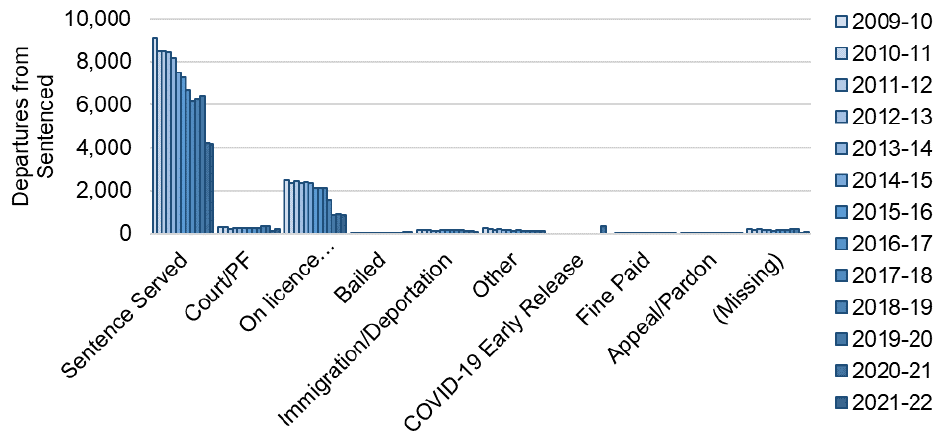
Liberations recorded as ‘sentence served’ fell by 2% in 2021-22, from 4,240 in 2020-21 to 4,175. Liberations to conditional release (on licence, parole or home detention curfew) also fell by a small amount (-1% from 906 in 2020-21 to 898 in 2021-22).
Liberations by the court or procurator fiscal increased from 120 to 189 over the same time period. There was also an increase in liberations to bail, from 71 in 2020-21 to 80 in 2021-22. These liberation types, generally associated with remand prisoners, give further indication of individuals moving from sentenced to remand prior to departure, as discussed in section 9.1.
Under emergency legislation introduced at the beginning of the Covid pandemic[46], 348 prisoners were released in 2020-21. There were no further such releases in 2021-22.
Contact
Email: Justice_Analysts@gov.scot
There is a problem
Thanks for your feedback